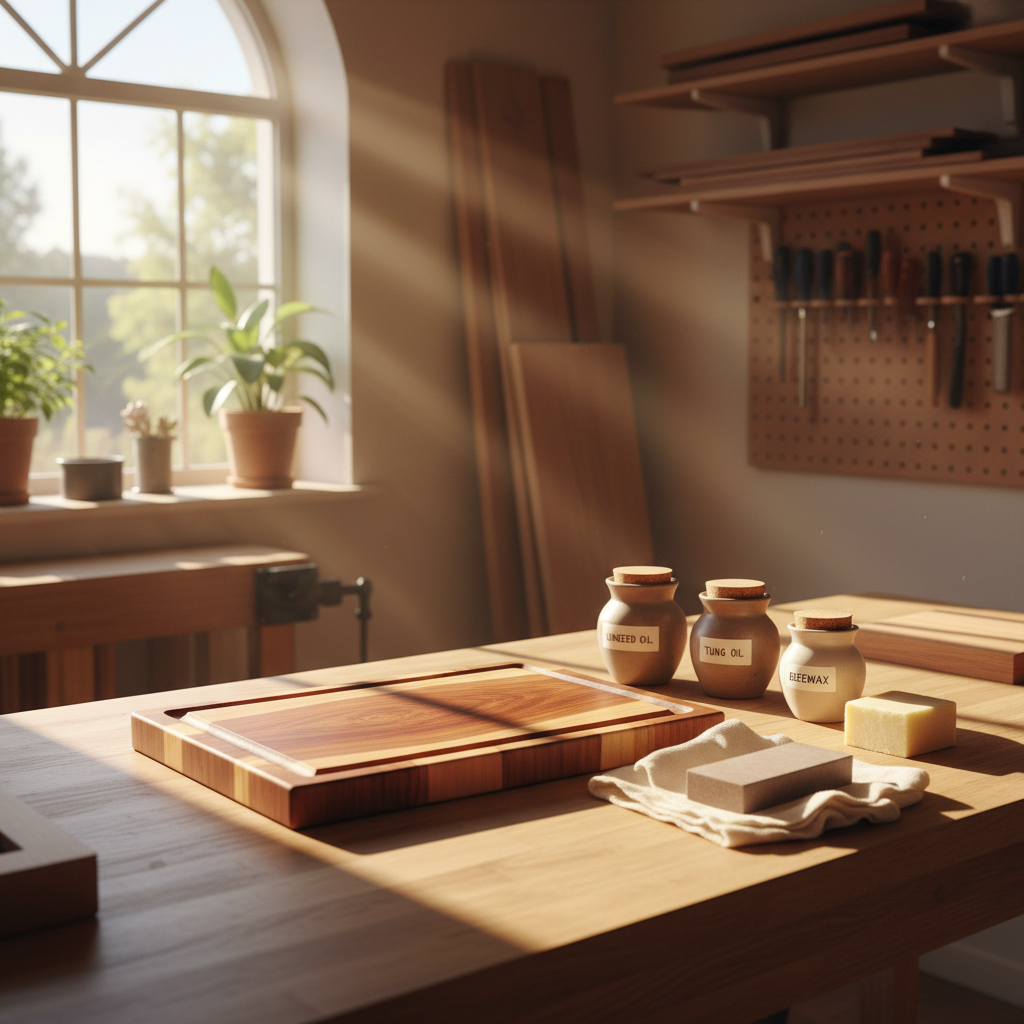There’s something incredibly satisfying about working with wood, isn’t there? The smell of sawdust, the feel of a freshly planed surface, the way grain patterns reveal themselves – it’s a craft that coects us to nature. But then comes the finishing stage, and for many of us, that’s where the eco-conscious alarm bells start ringing. Traditional wood finishes often come loaded with harsh chemicals, volatile organic compounds (VOCs), and ingredients that are anything but natural. If you’re like me, you want a finish that not only protects and beautifies your woodworking projects but also aligns with your values: health, sustainability, and respect for our planet.
Good news! You don’t have to compromise. Over my years of working with wood, I’ve experimented with countless finishing methods, and I’ve become a huge advocate for natural oils and waxes. They offer stuing aesthetics, durable protection, and a peace of mind that synthetic alternatives simply can’t match. So, let’s ditch the chemicals and dive into the wonderful world of natural, eco-friendly wood finishing.
Why Go Natural? The Hidden Costs of Conventional Finishes
I remember when I first started out, I just grabbed whatever polyurethane or varnish was on sale. It seemed like the standard. But as I spent more time in my workshop, the strong fumes, the need for respirators, and the difficulty of proper disposal started to bother me. I began to research, and what I found was eye-opening.
Conventional finishes often contain high levels of VOCs, which are gases emitted from certain solids or liquids. These can contribute to poor indoor air quality, cause respiratory problems, headaches, and even more serious health issues with prolonged exposure. Beyond personal health, the production and disposal of these chemical-laden products have a significant environmental footprint, from factory emissions to non-biodegradable waste.
Switching to natural oils and waxes isn’t just a trend; it’s a commitment to a healthier workshop, a safer home, and a cleaner environment. Most natural finishes are derived from renewable resources, are biodegradable, and once cured, are completely non-toxic – often even food-safe! Plus, in my experience, they just feel better to work with. The scent of beeswax or linseed oil is far more appealing than chemical fumes, trust me.
Understanding Your Options: Oils vs. Waxes
Before we get into the specific products, let’s clarify the fundamental difference between oils and waxes when it comes to wood finishing. Think of it like skincare for your wood:
-
Oils: These are penetrative finishes. They soak deep into the wood fibers, polymerizing (hardening) within the wood. This strengthens the wood from within, accentuates the natural grain, and offers a more “natural” feel. Oils provide excellent water resistance and repairability, as you can often just reapply locally if damage occurs.
-
Waxes: These are surface finishes. They sit on top of the wood, forming a protective, usually softer layer. Waxes are great for adding a beautiful sheen, a silky smooth feel, and a degree of scratch and moisture resistance. They often complement oil finishes by adding an extra layer of protection and luster.
In many cases, the best results come from combining both! An oil base for deep protection, followed by a wax coat for added durability and a lovely tactile finish. It’s a duo that works wonders.
The Star Players: Best Natural Oils for Wood Finishing
When it comes to natural oils, you’ll encounter a few main types, each with its unique characteristics. I’ve used all of these extensively, and I can tell you they each have their perfect application.
Linseed Oil (Flaxseed Oil)
This is probably the most traditional and widely knowatural wood finish. Derived from the flax plant, linseed oil penetrates deeply, enhancing the wood’s grain and giving it a warm, slightly amber tone. You’ll often find it in two forms: raw and boiled.
- Raw Linseed Oil: Penetrates very deeply but takes an eternity to dry (days, even weeks!). It’s not typically recommended for standalone finishes unless you have extreme patience.
- Boiled Linseed Oil (BLO): This isn’t actually “boiled” in the traditional sense, but rather treated with metallic dryers to speed up the curing process. It’s my go-to for many general projects like tool handles, furniture bases, or anything where I want that classic, deep oil finish. It’s cost-effective and easy to apply.
Pros: Deep penetration, classic look, cost-effective, easy to apply, renewable resource.
Cons: Can yellow over time, BLO contains petroleum distillates (check labels for pure vs. added dryers), *most importantly, rags soaked in BLO can spontaneously combust if not properly disposed of*. Always hang rags flat to dry or immerse them in water before disposal!
Tung Oil
Originating from the nuts of the tung tree, this oil is a superstar for durability and water resistance. Pure tung oil cures to a hard, flexible, and highly water-resistant finish that doesn’t yellow over time, making it excellent for kitchen countertops, dining tables, or outdoor furniture. It offers a more matte, natural look than linseed oil.
Pros: Excellent water resistance, very durable, doesn’t yellow, natural matte finish, non-toxic once cured, food-safe.
Cons: More expensive than linseed oil, slower drying than BLO (but faster than raw linseed), ensure you buy “pure” tung oil as many commercial products labeled “Tung Oil Finish” are often thied varnishes or oil blends.
Walnut Oil
If you’re looking for a truly food-safe and beautiful finish for cutting boards, wooden utensils, or children’s toys, pure walnut oil is a fantastic choice. It imparts a lovely warm tone and is generally non-allergenic for most people (though always be mindful of nut allergies). I always tell people that for anything that touches food, walnut oil is a perfect, simple option.
Pros: Completely food-safe, beautiful warm tone, easy to apply, non-toxic.
Cons: Higher cost than some other oils, not as durable or water-resistant as tung oil, can go rancid if not stored properly or if the wood isn’t fully cured, *potential allergy concern for severe nut allergies*.
Hemp Seed Oil
A newer discovery for me in the world of natural finishes, hemp seed oil is gaining popularity, and for good reason. It’s derived from the seeds of the hemp plant (a different variety than caabis) and is entirely food-safe and zero-VOC. It penetrates well, dries relatively quickly, and leaves a beautiful soft, matte finish.
Pros: Food-safe, zero VOCs, dries faster than many other oils, lovely matte finish, good penetration, renewable.
Cons: Not as durable as tung oil for high-wear surfaces, less common in standard hardware stores, can be pricier.
Adding Protection & Sheen: Best Natural Waxes for Wood Finishing
Waxes are the icing on the cake, providing an extra layer of protection, a beautiful sheen, and an incredibly satisfying tactile feel. They’re often used in conjunction with an oil finish, or sometimes on their own for decorative pieces.
Beeswax
Beeswax is a classic for a reason. Its natural, earthy scent is wonderful, and it imparts a soft, low-luster sheen that feels incredibly smooth to the touch. It’s easy to apply, provides good moisture resistance, and is completely non-toxic and biodegradable. I love using beeswax on everything from small turned bowls to giving a final polish to furniture.
Pros: Natural sheen, lovely scent, easy to apply, adds protection, non-toxic, food-safe, renewable.
Cons: Not very durable on its own for high-wear surfaces, needs reapplication more frequently, can attract dust if applied too thickly.
Carnauba Wax
If you’re looking for something harder and with a higher sheen than beeswax, carnauba wax is your answer. Sourced from the leaves of the Brazilian palm tree, carnauba is one of the hardest natural waxes available. It offers excellent water resistance and a very durable, high-gloss finish. It’s often blended with other waxes or oils because its high melting point makes it challenging to apply purely.
Pros: Very hard, durable, high sheen, excellent water resistance, plant-based.
Cons: More difficult to apply due to high melting point, ofteeeds to be blended or dissolved in solvents (which might defeat the “eco-friendly” purpose if not chosen carefully), can be more expensive.
Candelilla Wax
For a plant-based alternative to beeswax, especially for vegan projects, candelilla wax is a great choice. It’s derived from the candelilla shrub and is harder than beeswax but softer than carnauba. It provides good protection and a nice sheen, making it suitable for smaller decorative items or as a component in blended wax finishes.
Pros: Plant-based, good hardness, vegan-friendly, good protective qualities.
Cons: Similar application challenges to carnauba (ofteeeds to be melted or blended), less common than beeswax.
Tips for Success: Applying Natural Finishes Like a Pro
Achieving a beautiful, durable natural finish isn’t difficult, but a few key practices will make all the difference. From my experience, these are the golden rules:
-
Preparation is Key: No matter what finish you choose, the quality of your sanding dictates the quality of your final look. Start with coarser grits and work your way down to at least 220-grit, or even finer for show pieces. Ensure the wood is absolutely dust-free before applying any finish. I use a vacuum, then a tack cloth, and finally a wipe-down with mineral spirits or denatured alcohol (allowing it to evaporate completely).
-
Thin Coats, Always: This is perhaps the most important tip. Natural oils and waxes work best when applied in multiple, very thin coats. Don’t try to flood the wood. Apply a thin layer, let it soak in, and then wipe off ALL excess. Seriously, wipe it off until the surface feels dry to the touch. Any excess that remains on the surface will become gummy or sticky and take forever to cure.
-
Patience is a Virtue: Natural finishes, especially oils, take time to cure. While they might feel dry to the touch in hours, full cure can take days, weeks, or even a month or more, depending on the oil and environmental conditions. Allow adequate drying time between coats and before putting the piece into use. Rushing this step leads to sticky, unsatisfying results.
-
Buffing for Sheen: For wax finishes or the final coats of oil, buffing with a clean, soft cloth (like an old cotton t-shirt or microfiber towel) will bring out the luster and smooth feel. Buff vigorously in small sections until you achieve the desired sheen.
-
Maintenance and Reapplication: Natural finishes aren’t impermeable shields like polyurethane. They are meant to be maintained. Over time, high-wear surfaces might need a refresh. A light sanding and another thin coat of your chosen oil or wax will bring them back to life. This is one of their greatest advantages – easy repairability!
-
Safety First (Again!): I caot stress this enough – rags soaked in drying oils (like linseed oil or tung oil) can spontaneously combust. After use, immediately hang them flat outdoors to dry, or immerse them completely in a bucket of water. Only dispose of them once they are fully dry and hardened, or soaking wet.
Conclusion
Embracing natural oils and waxes for your wood finishing projects is a rewarding journey. Not only will you create pieces with a unique warmth, depth, and tactile beauty that synthetic finishes often miss, but you’ll also be making a conscious choice for your health and the environment. It’s a return to traditional craftsmanship, a nod to sustainability, and a way to truly coect with the materials you’re using.
So, the next time you finish a piece, consider giving nature a helping hand. Experiment with a new oil, try a wax topcoat, and enjoy the process. You might just find, like I have, that the natural touch is the best touch of all. Happy woodworking!



